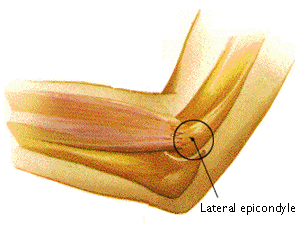

|
Back to |
| The Front Page |
| Archives |

|
Croquet sports injuries: #1. Tennis Elbow by Bob Burnett, Dip RGRT, MSCP, SRP Chartered Physiotherapist Posted November 25, 2000 |
Pathology of Tennis Elbow
Bob Burnett has specialised in sports injuries at his private practice in Southport, England, for the past 20 years. In less than four years of play, he has earned an Association handicap of 3.5. He's a Grade One coach and an assistant referee. We begin here a series of articles originally published in the Croquet Gazette and reprinted by permission. The articles, outlining the most common injuries affecting croquet players, are not written for medics and do not contain a lot of detail. Their purpose is to give the ordinary player an insight into what may be wrong and the wisest course of action. Burnett advises that if diagnosis is unsure or if symptoms persist, the injured player should seek a medical opinion.
Tennis elbow is a condition, despite its name, that has very little to do with the elbow joint. It describes a number of separate conditions which manifest themselves as an inflammation of the common extensor tendon origins on the lateral epicondyle of the humerus. (fig. 1) This inflammation is brought about by over use and strain of the muscles on the back of the forearm caused, in the main, by the actions of the wrist. It is characterised by pain and tenderness over the outside of the elbow, with pain often radiating down the back of the forearm.

|
| Fig 1: Aspect of arm and forearm showing position of the lateral epicondyle. |
Any actions of the forearm which involve gripping and rotation cause discomfort and pain. These actions include taking lids off jam jars, turning doorknobs, pouring water from the kettle, wringing out the washing, executing 30 yard rushes, etc.
The croquet player with the Standard grip on the mallet is more likely to suffer tennis elbow on the top arm. Players using the Solomon grip may suffer the condition in either arm, or both!
Diagnosing "Croquet Elbow"
The management and treatment of the condition depends largely on two factors: how bad it is and how long it has been present. It is important to get an accurate diagnosis before embarking on any treatment regime if other than conservative treatment is needed. The person carrying out this treatment will be able to give you a precise diagnosis.
As a rough guide, bend your elbow to a right angle, clench your fist with your palm downwards, and with your other thumb press over the point shown in figure I. If that hurts, it's tennis elbow!
Acute tennis elbow will often resolve spontaneously providing a sufferer abstains from the actions that cause pain. However, spontaneous resolution may take anything from a couple of weeks to a couple of years, and most players are reluctant to wait that long. On the other hand, a condition that has become chronic, and ignored, becomes far more difficult to cure and may in the end require surgery.
Finding the right treatment
There are a wide variety of treatments available; which is most suitable will depend on individual pathology.
- In the first instance, abstinence from aggravation should be
tried for a week or so. If this proves to be impossible
a tennis elbow band should be worn when doing any work with the
muscles of the forearm. This is a simple strap about an inch and
a half wide worn around the top of the forearm. Most sports shops
will sell these, with a simple Velcro fixing,
relatively cheaply. Don't be tempted to spend lots of money on
overly elaborate versions; they all to the same job.
- If there is no improvement, physiotherapy in the form of
ultra-sound and other techniques should be undertaken, perhaps in conjunction with a
hydrocortisone injection.
- If this is unsuccessful what is known as Mill's manipulation may be
performed, although it is important that this is done by a competent
practitioner.
- For stubborn cases immobilisation may be required either in a sling,
or plaster of Paris.
- If all else fails referral must be made to an orthopaedic surgeon who will decide whether surgery of one form or another may be required. Surgery gives good results and should be followed by a regime of progressive rehabilitation.
After treatment, critique your technique
It is important, following successful treatment, that the player's technique is examined to eliminate any bio-mechanical faults or to make any adjustments that may be needed. For example, increasing the diameter of the mallet shaft and thereby opening the grip slightly will help to prevent a possible recurrence of the condition.
Upcoming in this series: Frozen Shoulder. Reprinted by permission of the Croquet Gazette.